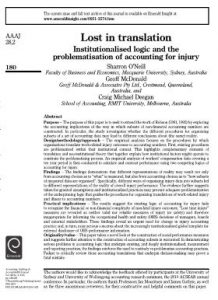 It seems that we are constantly being urged to innovate, to be creative and to think differently. This is equally true in the discipline of occupational health and safety (OHS), but part of thinking differently in the future should also involve reassessing the past.
It seems that we are constantly being urged to innovate, to be creative and to think differently. This is equally true in the discipline of occupational health and safety (OHS), but part of thinking differently in the future should also involve reassessing the past.
It is often said that many the OHS performance indicators, predominantly Lost Time Injury (LTI) calculations, have shown a “plateau-ing” of safety performance. From this common position, companies have moved to new OHS training strategies that involve behaviours, values, cultural norms, safety culture and other employee and organisational recalibrations. But what if the case in support of these strategies was not as strong as first thought? What if the “plateau-ing” did not exist or the increase in performance was not as strong as the LTI-based data seemed to indicate?
Academics, Sharron O’Neill, Geoff McDonald and Craig Michael Deegan, looked at the issue of institutional logic and OHS performance indicators in a research called “Lost in Translation” in 2015. The practical implications of their research says:
